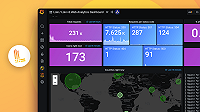Configuration
1-Local-Configuration-Example.yaml
# This is a complete configuration to deploy Loki backed by the filesystem.
# The index will be shipped to the storage via tsdb-shipper.
auth_enabled: false
server:
http_listen_port: 3100
common:
ring:
instance_addr: 127.0.0.1
kvstore:
store: inmemory
replication_factor: 1
path_prefix: /tmp/loki
schema_config:
configs:
- from: 2020-05-15
store: tsdb
object_store: filesystem
schema: v13
index:
prefix: index_
period: 24h
storage_config:
filesystem:
directory: /tmp/loki/chunks2-S3-Cluster-Example.yaml
# This is a complete configuration to deploy Loki backed by a s3-compatible API
# like MinIO for storage.
# Index files will be written locally at /loki/index and, eventually, will be shipped to the storage via tsdb-shipper.
auth_enabled: false
server:
http_listen_port: 3100
common:
ring:
instance_addr: 127.0.0.1
kvstore:
store: inmemory
replication_factor: 1
path_prefix: /loki
schema_config:
configs:
- from: 2020-05-15
store: tsdb
object_store: s3
schema: v13
index:
prefix: index_
period: 24h
storage_config:
tsdb_shipper:
active_index_directory: /loki/index
cache_location: /loki/index_cache
aws:
s3: s3://access_key:secret_access_key@custom_endpoint/bucket_name
s3forcepathstyle: true3-S3-Without-Credentials-Snippet.yaml
# If you don't wish to hard-code S3 credentials you can also configure an EC2
# instance role by changing the `storage_config` section.
storage_config:
aws:
s3: s3://region/bucket_name
4-GCS-Example.yaml
# This is a complete configuration to deploy Loki backed by a GCS.
# Index files will be written locally at /loki/index and, eventually, will be shipped to the storage via tsdb-shipper.
auth_enabled: false
server:
http_listen_port: 3100
common:
ring:
instance_addr: 127.0.0.1
kvstore:
store: inmemory
replication_factor: 1
path_prefix: /loki
schema_config:
configs:
- from: 2020-05-15
store: tsdb
object_store: gcs
schema: v13
index:
prefix: index_
period: 24h
storage_config:
tsdb_shipper:
active_index_directory: /loki/index
cache_location: /loki/index_cache
gcs:
bucket_name: replace_by_your_bucked_name5-BOS-Example.yaml
# This is a partial configuration to deploy Loki backed by Baidu Object Storage (BOS).
# The index will be shipped to the storage via tsdb-shipper.
common:
path_prefix: /tmp/loki
schema_config:
configs:
- from: 2020-05-15
store: tsdb
object_store: bos
schema: v13
index:
prefix: index_
period: 24h
storage_config:
bos:
bucket_name: bucket_name_1
endpoint: bj.bcebos.com
access_key_id: access_key_id
secret_access_key: secret_access_key6-Compactor-Snippet.yaml
# This partial configuration sets the compactor to use S3 and run the compaction every 5 minutes.
# Downloaded index files for compaction are stored in /loki/compactor.
compactor:
working_directory: /tmp/loki/compactor
compaction_interval: 5m7-Schema-Migration-Snippet.yaml
common:
path_prefix: /tmp/loki
schema_config:
configs:
# Starting from 2018-04-15 Loki should store indexes on BoltDB with the v11 schema
# using daily periodic tables and chunks on filesystem.
# The index tables will be prefixed with "index_".
- from: "2018-04-15"
store: boltdb-shipper
object_store: filesystem
schema: v11
index:
period: 24h
prefix: index_
# Starting from 2023-6-15 Loki should store indexes on TSDB with the v13 schema
# using daily periodic tables and chunks on AWS S3.
- from: "2023-06-15"
store: tsdb
object_store: s3
schema: v13
index:
period: 24h
prefix: index_8-alibaba-cloud-storage-Snippet.yaml
# This partial configuration uses Alibaba for chunk storage.
common:
path_prefix: /tmp/loki
schema_config:
configs:
- from: 2020-05-15
store: tsdb
object_store: alibabacloud
schema: v13
index:
prefix: index_
period: 24h
storage_config:
tsdb_shipper:
active_index_directory: /loki/index
cache_location: /loki/index_cache
alibabacloud:
bucket: <bucket>
endpoint: <endpoint>
access_key_id: <access_key_id>
secret_access_key: <secret_access_key>9-S3-With-SSE-KMS-Snippet.yaml
# This partial configuration uses S3 for chunk storage and a KMS CMK for encryption.
storage_config:
aws:
s3: s3://access_key:secret_access_key@region/bucket_name
sse:
type: SSE-KMS
kms_key_id: 1234abcd-12ab-34cd-56ef-1234567890ab10-Expanded-S3-Snippet.yaml
# S3 configuration supports an expanded configuration.
# Either an `s3` endpoint URL can be used, or an expanded configuration can be used.
storage_config:
aws:
bucketnames: bucket_name1, bucket_name2
endpoint: s3.endpoint.com
region: s3_region
access_key_id: s3_access_key_id
secret_access_key: s3_secret_access_key
insecure: false
http_config:
idle_conn_timeout: 90s
response_header_timeout: 0s
insecure_skip_verify: false
s3forcepathstyle: true
11-COS-HMAC-Example.yaml
# This partial configuration uses IBM Cloud Object Storage (COS) for chunk storage. HMAC will be used for authenticating with COS.
common:
path_prefix: /tmp/loki
schema_config:
configs:
- from: 2020-10-01
store: tsdb
object_store: cos
schema: v13
index:
period: 24h
prefix: index_
storage_config:
cos:
bucketnames: <bucket1, bucket2>
endpoint: <endpoint>
region: <region>
access_key_id: <access_key_id>
secret_access_key: <secret_access_key>12-COS-APIKey-Example.yaml
# This partial configuration uses IBM Cloud Object Storage (COS) for chunk storage. APIKey will be used for authenticating with COS.
common:
path_prefix: /tmp/loki
schema_config:
configs:
- from: 2020-10-01
store: tsdb
object_store: cos
schema: v13
index:
period: 24h
prefix: index_
storage_config:
cos:
bucketnames: <bucket1, bucket2>
endpoint: <endpoint>
region: <region>
api_key: <api_key_to_authenticate_with_cos>
service_instance_id: <cos_service_instance_id>
auth_endpoint: <iam_endpoint_for_authentication>13-COS-Trusted-Profile-Example.yaml
# This partial configuration uses IBM Cloud Object Storage (COS) for chunk storage.
# A trusted profile will be used for authenticating with COS. We can either pass
# the trusted profile name or trusted profile ID along with the compute resource token file.
# If we pass both trusted profile name and trusted profile ID it should be of
# the same trusted profile.
# In order to use trusted profile authentication we need to follow an additional step to create a trusted profile.
# For more details about creating a trusted profile, see https://cloud.ibm.com/docs/account?topic=account-create-trusted-profile&interface=ui.
common:
path_prefix: /tmp/loki
schema_config:
configs:
- from: 2020-10-01
store: tsdb
object_store: cos
schema: v13
index:
period: 24h
prefix: index_
storage_config:
cos:
bucketnames: <bucket1, bucket2>
endpoint: <endpoint>
region: <region>
auth_endpoint: <iam_endpoint_for_authentication>
cr_token_file_path: <path_to_compute_resource_token>
trusted_profile_name: <name_of_the_trusted_profile> # You can also use trusted_profile_id instead of trusted_profile_name15-Memberlist-Ring-Snippet.yaml
# This partial configuration uses memberlist for the ring.
common:
ring:
kvstore:
store: memberlist
replication_factor: 1
path_prefix: /loki
memberlist:
join_members:
# You can use a headless k8s service for all distributor, ingester and querier components.
- loki-gossip-ring.loki.svc.cluster.local:7946 # :7946 is the default memberlist port.16-Azure-Account-Name-Example.yaml
# This partial configuration uses Azure for chunk storage
storage_config:
azure:
# For the account-key, see docs: https://docs.microsoft.com/en-us/azure/storage/common/storage-account-keys-manage?tabs=azure-portal
account_key: <azure_blob_access_key>
account_name: <azure_account_name>
container_name: <azure_storage_bucket_name>
use_managed_identity: false
# Providing a user assigned ID will override use_managed_identity
#user_assigned_id: <user-assigned-identity-id>
request_timeout: 0
# Configure `endpoint_suffix` if you are using private azure cloud like azure stack hub and will use this endpoint suffix to compose container and blob storage URL. Ex: https://account_name.endpoint_suffix/container_name/blob_name
#endpoint_suffix: <endpoint-suffix>
# If `connection_string` is set, the `account_name` and `endpoint_suffix` values will not be used. Use this method over `account_key` if you need to authenticate via an SAS token. Or if you use the Azurite emulator.
#connection_string: <connection-string>17-Azure-Service-Principal-Example.yaml
# This partial configuration uses Azure for chunk storage and a service principal for authentication
storage_config:
azure:
use_service_principal: true
# Azure tenant ID used to authenticate through Azure OAuth
tenant_id: <tenant-id>
# Azure Service Principal ID
client_id: <client-id>
# Azure Service Principal secret key
client_secret: <client-secret>
# See https://docs.microsoft.com/en-us/azure/storage/blobs/storage-blobs-introduction#containers
container_name: <azure_storage_bucket_name>
request_timeout: 0


